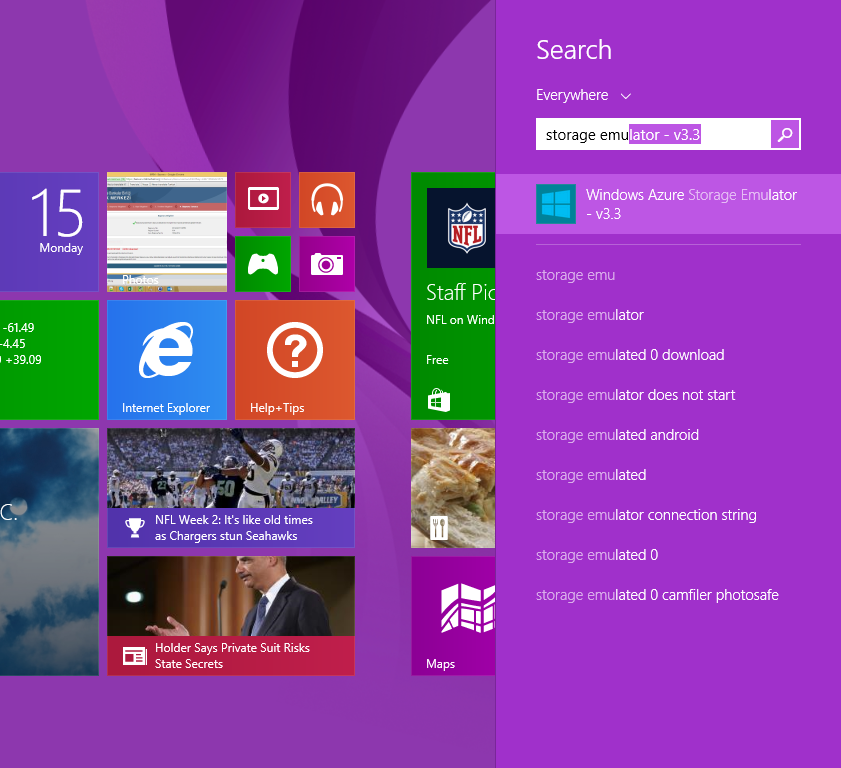

You can find your storage account's connection strings in the Azure portal.

You can map your own domain or subdomain to the Blob service for your storage account so that users can reach it using the custom domain or subdomain.Īlso Know, where is Azure storage connection string? Subsequently, question is, what URL format can blobs be accessed from? By default, the URL for accessing the Blob service in a storage account is. As soon as you run the Web Roles (or Worker Roles), one of the components of the Azure SDK gets triggered. The Azure Compute Emulator enables us to test and debug the Azure Cloud Services in our local environment without deploying the Cloud Service to Azure. Moreover, what is Microsoft Azure compute emulator? Select the emulator from the list of displayed applications.
#AZURE STORAGE EMULATOR WINDOWS#
#AZURE STORAGE EMULATOR CODE#
So, now our code is ready to perform Upload and Fetch files operation from the Azure local Storage Emulator. Var response = await container.ListBlobsSegmentedAsync("", true, BlobListingDetails.None, 500, null, null, null) Get all the uploaded file URLs from Azure storage Var fileURL = await GetReadUrlAsync(responseGuid) Var responseGuid = await UploadFromFileAsync("D://Download.jpg", "image/png") //Give the File here with File Type Upload file and get URL of the file from Azure storage Using (var fileStream = System.IO.File.OpenRead(filePath))Īwait blockBlob.UploadFromStreamAsync(fileStream) String sasBlobToken = blob.GetSharedAccessSignature(sasConstraints) Īsync public Task UploadFromFileAsync(string filePath, string contentType)ĬloudBlockBlob blockBlob = container.GetBlockBlobReference(guid) ī = contentType SasConstraints.SharedAccessExpiryTime = () SasConstraints.SharedAccessExpiryTime = (hours) SasConstraints.SharedAccessStartTime = (-5) SasConstraints.Permissions = SharedAccessBlobPermissions.Read SharedAccessBlobPolicy sasConstraints = new SharedAccessBlobPolicy() _container = client.GetContainerReference(containerName) Īsync public Task GetReadUrlAsync(string blobId, int hours = 0)ĬloudBlobContainer container = await GetContainerAsync() ĬloudBlockBlob blob = container.GetBlockBlobReference(blobId) If (_container != null) return _container ĬloudBlobClient client = StorageAccount.CreateCloudBlobClient() Private CloudStorageAccount StorageAccount Private CloudStorageAccount _storageAccount Private readonly string containerName = "mycontainer" Private readonly string connectionString = "UseDevelopmentStorage=true" Step-2: Add HomeController.cs in Controllers folder : using Step-1: In the NuGet Package Manager, search for and select WindowsAzure.Storage. Note: Remember you have to run this emulator before you run the project.
#AZURE STORAGE EMULATOR INSTALL#
You can download the Azure Storage Emulator here and Install it on your pc. When you’re happy with how your application is working in the emulator, switch to using an Azure subscription account in the cloud. You can test your app against the storage services locally without creating an Azure subscription account or incurring any costs. The Microsoft Azure Storage Emulator provides functionality to emulates the Azure Blob, Queue, and Table services for local development purposes.


 0 kommentar(er)
0 kommentar(er)
